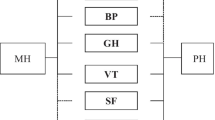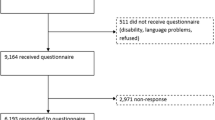Abstract
Objective To compare the two higher order factor structures of the Short-Form 36 (SF-36) Health Survey, using exploratory factor analytic methods and structural equation modeling (SEM). Methods Two population data sets were used. A stratified representative sample (n = 1,005) of the Greek general population was approached for interview. This survey containing the SF-36 was used to obtain component score coefficients from principal components analysis and orthogonal rotation. These coefficients were then used in the second data set (n = 1,007) of the Greek adult general population to compute scores for the physical component summary and the mental component summary of the SF-36. The second data set was also used to obtain factor scores for physical and mental health measures, applying SEM. Results Exploratory factor analysis supported the existence of two principal components that are the basis for summary physical and mental health measures. SEM showed that models assuming that physical and mental health are correlated provided a better fit to the data than models assuming independence between physical and mental health. However, all eight dimensions of SF-36 should be included in the construction of summary scores. Conclusions These results confirm the multidimensional structure of the SF-36, the correlational equivalence between standard summary measures and SEM-based second-order factor scores, and underscore the feasibility of multinational comparisons of health status using this instrument.




Similar content being viewed by others
Abbreviations
- SEM:
-
Structural equation modeling
- PCS:
-
Physical component summary
- MCS:
-
Mental component summary
- RMSEA:
-
Root mean squared error of approximation
References
Geigle, R., & Jones, S. B. (1990). Outcomes measurement: A report from the front. Inquiry, 27, 7–13.
Lansky, D., Butler, J. B. V., & Waller, F. T. (1992). Using health status measures in the hospital setting: From acute care to “outcomes management”. Medical Care, 30(Suppl), MS57–MS73. doi:10.1097/00005650-199205001-00006.
Phillips, R. C., & Lansky, D. J. (1992). Outcomes management in heart valve replacement surgery: Early experience. The Journal of Heart Valve Disease, 1, 42–50.
Alonso, J., Ferrer, M., Gandek, B., Ware, J. E., Aaronson, N. K., Mosconi, P., et al. (2004). Health-related quality of life associated with chronic conditions in eight countries: Results from the International Quality of Life Assessment (IQOLA) project. Quality of Life Research, 13, 283–298. doi:10.1023/B:QURE.0000018472.46236.05.
Baker, F., Haffer, S. C., & Denniston, M. (2003). Health-related quality of life of cancer and noncancer patients in medicare managed care. Cancer, 97, 674–681. doi:10.1002/cncr.11085.
Camilleri-Brennan, J., & Steele, R. J. C. (2001). The impact of recurrent rectal cancer on quality of life. European Journal of Surgical Oncology, 27, 349–353. doi:10.1053/ejso.2001.1115.
Ware, J. E., Kosinski, M., & Gandek, B. (2003). SF-36 Health Survey: Manual and interpretation guide. Lincoln: QualityMetric Inc.
Ware, J. E., & Gandek, B. (1998). Overview of the SF-36 Health Survey and the International Quality of Life Assessment (IQOLA) project. Journal of Clinical Epidemiology, 51, 903–912. doi:10.1016/S0895-4356(98)00081-X.
Ware, J. E., Kosinski, M., Gandek, B., Aaronson, N. K., Apolone, G., Bech, P., et al. (1998). The factor structure of the SF-36 Health Survey in 10 countries: Results from the IQOLA project. Journal of Clinical Epidemiology, 51, 1159–1165. doi:10.1016/S0895-4356(98)00107-3.
Ware, J. E., Gandek, B., Kosinski, M., Aaronson, N. K., Apolone, G., Brazier, J., et al. (1998). The equivalence of SF-36 summary health scores estimated using standard and country-specific algorithms in 10 countries: Results from the IQOLA project. Journal of Clinical Epidemiology, 51, 1167–1170. doi:10.1016/S0895-4356(98)00108-5.
Ware, J. E., & Kosinski, M. (2003). SF-36 Physical and mental health summary scales: A manual for users of version 1. Lincoln: QualityMetric Inc.
Gandek, B., Sinclair, S. J., Kosinski, M., & Ware, J. E. (2004). Psychometric evaluation of the SF-36 Health Survey in medicare managed care. Health Care Financing Review, 25, 5–25.
Gandek, B., Ware, J. E., Aaronson, N. K., Apolone, G., Bjorner, J. B., Brazier, J. E., et al. (1998). Cross-validation of item selection and scoring for the SF-12 Health Survey in nine countries: Results from the IQOLA project. Journal of Clinical Epidemiology, 51, 1171–1178. doi:10.1016/S0895-4356(98)00109-7.
Cunningham, W. E., Nakazono, T. T., Tsai, K. L., & Hays, R. D. (2003). Do differences in methods for constructing SF-36 physical and mental health summary measures change their associations with chronic medical conditions and utilization? Quality of Life Research, 12, 1029–1035. doi:10.1023/A:1026191016380.
Taft, C., Karlsson, J., & Sullivan, M. (2001). Do SF-36 summary component scores accurately summarize subscale scores? Quality of Life Research, 10, 395–404. doi:10.1023/A:1012552211996.
Ware, J. E., & Kosinski, M. (2001). Interpreting SF-36 summary health measures: A response. Quality of Life Research, 10, 405–413. doi:10.1023/A:1012588218728.
Fabrigar, L. R., Wegener, D. T., MacCallum, R. C., & Strahan, E. J. (1999). Evaluating the use of exploratory factor analysis in psychological research. Psychological Methods, 4, 272–299. doi:10.1037/1082-989X.4.3.272.
Comrey, A. L. (1988). Factor-analytic methods of scale development in personality and clinical psychology. Journal of Consulting and Clinical Psychology, 56, 754–761. doi:10.1037/0022-006X.56.5.754.
Wood, J. M., Tataryn, D. J., & Gorsuch, R. L. (1996). Effects of under-and overextraction on principal axis factor analysis with varimax rotation. Psychological Methods, 1, 354–365. doi:10.1037/1082-989X.1.4.354.
Hays, R. D., & Morales, L. S. (2001). The RAND-36 measure of health-related quality of life. Annals of Medicine, 33, 350–357. doi:10.3109/07853890109002089.
Hays, R. D., Prince-Embury, S., & Chen, H. (1998). RAND-36 health status inventory. San Antonio: The Psychological Corporation.
Wilson, D., Parsons, J., & Tucker, G. (2000). The SF-36 summary scales: Problems and solutions. Social and Preventive Medicine, 45, 239–246.
Kline, R. B. (1998). Principles and practice of structural equation modeling. New York: The Guilford Press.
Anagnostopoulos, F., Niakas, D., & Pappa, E. (2005). Construct validation of the Greek SF-36 Health Survey. Quality of Life Research, 14, 1959–1965. doi:10.1007/s11136-005-3866-8.
Pappa, E., Kontodimopoulos, N., & Niakas, D. (2005). Validating and norming of the Greek SF-36 Health Survey. Quality of Life Research, 14, 1433–1438. doi:10.1007/s11136-004-6014-y.
Joreskog, K., & Sorbom, D. (1996). LISREL 8: User’s reference guide. Chicago: Scientific Software International.
Hays, R. D., Sherbourne, C. D., & Mazel, R. M. (1993). The RAND 36-item health survey 1.0. Health Economics, 2, 217–227. doi:10.1002/hec.4730020305.
Keller, S. D., Ware, J. E., Bentler, P. M., Aaronson, N. K., Alonso, J., Apolone, G., et al. (1998). Use of structural equation modeling to test the construct validity of the SF-36 Health Survey in ten countries: Results from the IQOLA project. Journal of Clinical Epidemiology, 51, 1179–1188. doi:10.1016/S0895-4356(98)00110-3.
Hann, M., & Reeves, D. (2008). The SF-36 scales are not accurately summarised by independent physical and mental component scores. Quality of Life Research, 17, 413–423. doi:10.1007/s11136-008-9310-0.
Hu, L., & Bentler, P. M. (1998). Fit indices in covariance structure modeling: Sensitivity to underparameterized model misspecification. Psychological Methods, 3, 424–453. doi:10.1037/1082-989X.3.4.424.
McDonald, R. P., & Ho, M. H. R. (2002). Principles and practice in reporting structural equation analyses. Psychological Methods, 7, 64–82. doi:10.1037/1082-989X.7.1.64.
Hays, R. D., Revicki, D., & Coyne, K. S. (2005). Application of structural equation modeling to health outcomes research. Evaluation & the Health Professions, 28, 295–309. doi:10.1177/0163278705278277.
Anderson, T. W., & Rubin, H. (1956). Statistical inference in factor analysis. In J. Neyman (Ed.), Proceedings of the Third Berkeley Symposium on Mathematical Statistics and Probability, Vol. 5 (pp. 111–150). Berkeley: University of California Press.
Simon, G. E., Revicki, D. A., Grothaus, L., & Vonkorff, M. (1998). SF-36 summary scores: Are physical and mental health truly distinct? Medical Care, 36, 567–572. doi:10.1097/00005650-199804000-00012.
Nortvedt, M. W., Riise, T., Myhr, K., & Nyland, H. I. (2000). Performance of the SF-36, SF-12, and RAND-36 summary scales in a multiple sclerosis population. Medical Care, 38, 1022–1028. doi:10.1097/00005650-200010000-00006.
Farivar, S. S., Cunningham, W. E., & Hays, R. D. (2007). Correlated physical and mental health summary scores for the SF-36 and SF-12 Health Survey, v. 1. Health and Quality of Life Outcomes, 5, 54. doi:10.1186/1477-7525-5-54.
Schmitz, N., & Kruse, J. (2007). The SF-36 summary scores and their relation to mental disorders: Physical functioning may affect performance of the summary scores. Journal of Clinical Epidemiology, 60, 163–170. doi:10.1016/j.jclinepi.2006.04.003.
Acknowledgements
The authors gratefully acknowledge the helpful comments and constructive suggestions received from Professor Ron Hays and the anonymous reviewers.
Author information
Authors and Affiliations
Corresponding author
Rights and permissions
About this article
Cite this article
Anagnostopoulos, F., Niakas, D. & Tountas, Y. Comparison between exploratory factor-analytic and SEM-based approaches to constructing SF-36 summary scores. Qual Life Res 18, 53–63 (2009). https://doi.org/10.1007/s11136-008-9423-5
Received:
Accepted:
Published:
Issue Date:
DOI: https://doi.org/10.1007/s11136-008-9423-5




